Clematis Stasik - planting and care
The undersized hybrid clematis Stasik, bred by the domestic breeder Maria F. Sharonova in 1972, is recognized as the king of lianas, since it has two qualities - lush flowering and an abundance of colors. Consider what a shrub looks like, how to plant it correctly and what kind of care is required after that.
- Characteristics of the variety
- Landing rules
- Timing
- Place and soil
- Seedling preparation
- Landing technology
- Care features
- Watering
- Top dressing
- Pruning
- Preparing for winter
- Reproduction methods
- By dividing the rhizome
- Stem layering
- Cuttings
- Diseases and pests
- Prophylaxis
- How to apply in garden design
- Gardeners reviews
- Useful videos
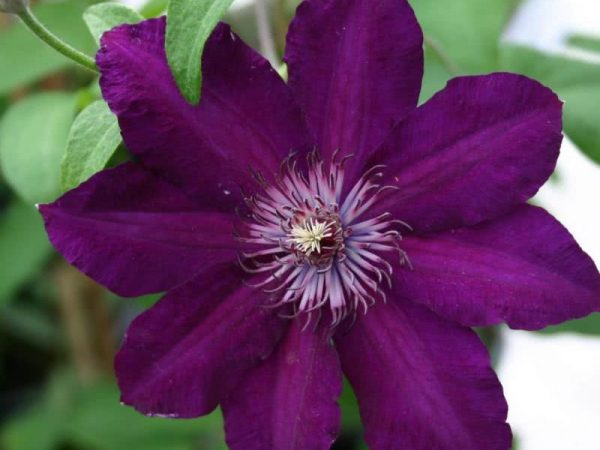
Stasik clematis
Characteristics of the variety
Hybrid clematis Stasik (lat.clematis stasik) is a perennial vine. The plant has good frost resistance - zone 4-9, so it can be successfully cultivated in regions with warm, temperate and continental climates.
Disease resistance is good, but subject to all the rules of care and maintenance.
External parameters:
- shrub height - from 1.2 to 1.8 m;
- shoots are tough, weaving, dark brown;
- along the entire length of the stems, small leaves of a bright green color with a smooth surface, oval in shape with a pointed tip develop;
- inflorescences of medium size - 9-12 cm in circumference;
- rich red petals;
- one flower contains 5 sepals, which create the effect of a five-pointed star.
Landing rules
The cultivation of this variety is not much different from the planting conditions and maintenance of other varieties. The main thing is to choose high-quality planting material, a suitable place for planting and a nutritious soil composition.
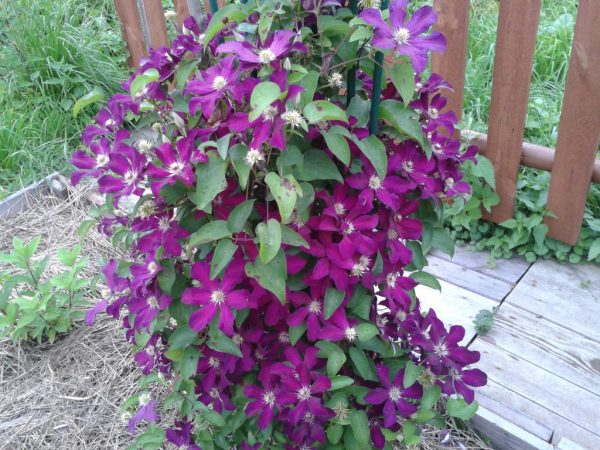
Clematis stasik
Timing
Spring is the best time to plant young seedlings. This is usually done in the second or third decade of April.
In the south and in the Middle Lane, early autumn planting is allowed (until the end of September), so that the seedlings have time to take root before the onset of the first frost.
During planting, it is important that the soil warms up to 10-12 ° C, and the outdoor temperature reaches 15 ° C.
Place and soil
The best places to grow this vine are near walls, arches, arbors, terraces.
Vertical surfaces will provide the shoots with a solid support, which will have a positive effect on branching and further growth. The main thing is to indent at a distance of 50 cm when planting, so that the root system fully develops.
Clematis loves to grow in a sunny area protected from drafts and the scorching sun at lunchtime. It does not tolerate stagnant moisture, therefore, it is planted on a hill or provides good drainage. The optimum depth of groundwater is at least 2 m.
The soil should be fertile, light, loose and with a neutral acidity level. Depending on its type, different components are introduced per 1 m²:
- on loamy or heavy clay soil - 20 kg of sand, perlite or vermiculite;
- on sandy loam soil - 2 buckets of clay;
- if the acidity exceeds the norm (6 units), sprinkle with dolomite flour, slaked lime, chalk or calcite (400 g).
After adding all the necessary components, deep digging, leveling and watering are carried out.
Seedling preparation
If you want to get a real seedling with all the varietal characteristics of the mother bush, you should go shopping in one of the horticultural nurseries.
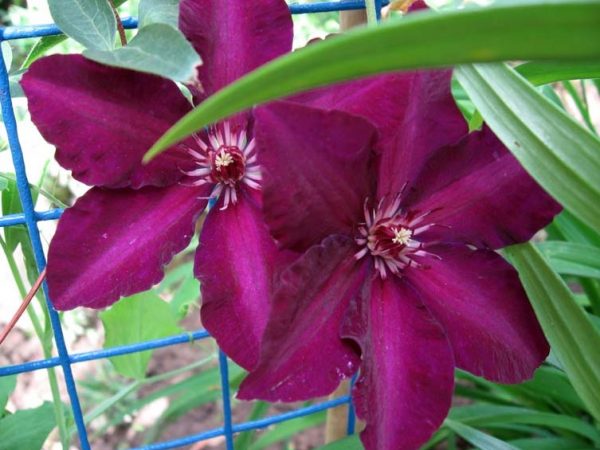
Clematis stasik photo and description
It is better to choose plants with an earthen ball or planted in containers. It is important that the crown consists of several shoots, densely covered with foliage. Such specimens have a well-developed root system, therefore, they will successfully survive transplantation into open ground.
Carefully inspect the aerial part - the stems should be flexible, without mechanical injury and signs of disease. Leaves and buds are juicy, bright green, without specks, holes, dry fragments.
Before planting, the bushes are removed from the pot, together with a lump of earth, they are lowered into a basin of water for a couple of hours. Then the roots are pruned 2-3 cm in length to stimulate the growth of new processes.
Landing technology
Clematis require a lot of space, so when growing in groups or when planting with other vegetation, you need to indent at least 1 m.Thus, there will be no competition for moisture, oxygen and nutrients.
The pits are harvested a month before planting - their approximate parameters are 50x60 cm. A drainage layer is poured at the bottom of each hole. Take rubble, pebbles, screenings or brick chips. From above, half the volume, fill with a fertile mixture - mix a bucket of dug soil with 5 kg of humus (compost). Add 100 g of superphosphate, 80 g of potassium nitrate and 300 g of ash.
The earth is trampled down, a hole is pulled out in the center, the rhizome is lowered into it, covered with soil to the top, compacted, watered. One seedling consumes 20 liters of water. So that the moisture does not evaporate quickly and the roots do not dry out, after moistening, they add mulch from peat or sawdust.
Additionally, you can plant low-growing crops in the near-trunk zone - calendula, marigolds, primrose or mint. They create good shading and repel harmful insects.
After planting, the stems are tied to a support so that they grow in the right direction.
When planting, it is important to observe one rule - in plants with lignified stems, the root collar is deepened by 10-12 cm. Saplings with green shoots are planted without immersion in the soil, otherwise the vine will die.
In the first two weeks after planting, young shrubs need shading at lunchtime. Burlap or agrofibre is used as a shelter.
Care features
Watering
For successful and fast rooting, young seedlings require frequent and moderate watering - they are moistened daily. Consumption - a bucket of water for each bush.
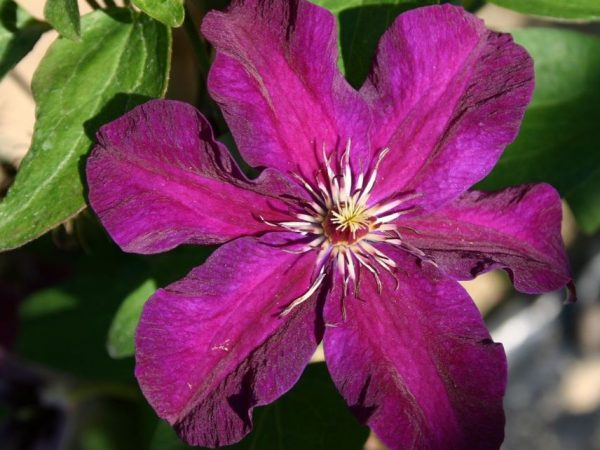
Clematis stasik description
Later, the frequency is reduced. If the summer turned out to be dry, then you need to water it after three days.
In rainy weather, they are guided by the condition of the soil - if its surface has dried out to a depth of 5-6 cm, it's time to water the shrub.
It is imperative to moisturize at the beginning of spring, two weeks before the formation of buds and after the end of flowering, as well as in autumn, when the vine sheds its leaves.
Use thawed, rain or settled water at room temperature to avoid hypothermia of the roots.
In extreme heat and drought, the crown is irrigated to prevent wilting and loss of decorativeness. The procedure is carried out in the evening.
Top dressing
In the first three years, the seedlings have enough nutrients that were laid down during planting.
In the fourth year, they begin to make top dressing annually several times per season:
- In early spring, they are fed with nitrogen-containing preparations. A solution of ammonium nitrate, nitrophoska or urea is used - 15 g is consumed per 10 liters of water. 5 liters of working fluid are poured under one bush.
- Two weeks before the formation of buds, they are fed with a complex composition - superphosphate is mixed with potassium sulfate - 1 tbsp each. l. each component in a bucket of water. Consumption for 1 m² - 5 liters.
- The same fertilizer is used to feed the shrub after flowering.
- In late autumn, when the liana sheds foliage, compost, humus or peat are embedded in the trunk circle.
In order for the roots to absorb nutrients faster, top dressing is combined with watering.
Pruning
This variety of clematis belongs to the third pruning group, so it is drastically trimmed several times a year:
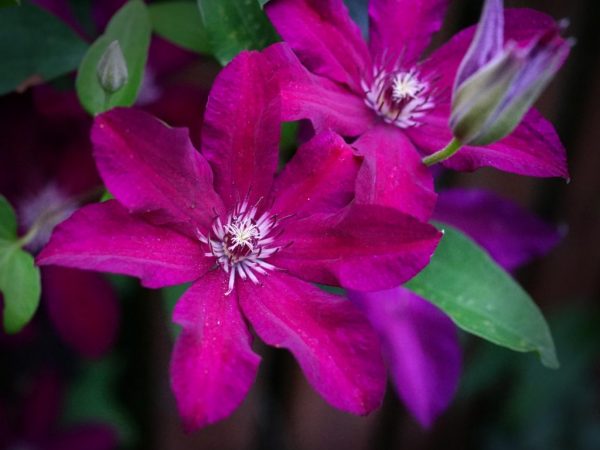
Clematis variety Stasik
- in the fall, twigs of last year are shortened, on which dry flowers remain - cut by 30 cm, leaving at least 2 and no more than 4 buds;
- for better branching in early spring, pinch the apical parts of both adult bushes and annual seedlings;
- to speed up and improve the quality of flowering, the shoots are slightly trimmed, leaving a length of about 50 cm.
At the same time, vines growing in the wrong direction are cut out, and frozen, dried, wind-broken stems, yellowed leaves are also removed on the ring.
All manipulations are carried out using a sterile and sharp secateurs, scissors. After pruning, the crown is irrigated with a solution of copper sulfate.
Preparing for winter
At an early age, clematis is insulated for the winter:
- the trunk circle is mulched with peat, sawdust;
- shoots are removed from the support, twisted into a ring, lowered to the ground and fixed with hairpins;
- from above the vine is covered with fallen leaves, then covered with burlap or spruce branches.
When spring comes and the threat of recurrent frosts has passed, the insulating material is removed, the branches are straightened and tied to a support.
Reproduction methods
There are several ways to propagate this shrub yourself. By adhering to the basic rules of harvesting and planting the material, you can achieve a positive result.
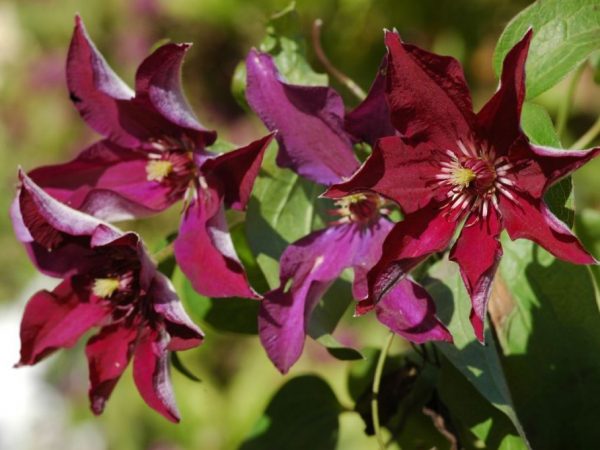
Clematis stasik photo description
By dividing the rhizome
This method is used in relation to old bushes, which began to grow slowly and bloom sparsely. This is a sign that they need to be rejuvenated.
The plant is watered abundantly, after an hour it is dug in and, together with a lump of earth, is placed in a container of water. The roots washed from the soil are dried, then cut into pieces with a garden shovel or knife. Each delenka should have 2-3 roots, one stem with several buds.
Places of cuts are sprinkled with charcoal, dried, seated separately according to the above scheme.
Stem layering
Another effective method used in late autumn. On the bush, choose a flexible and long vine, close to the ground.
A trench is pulled out nearby, the stem is lowered into it to a depth of 5-6 cm. For fixation, it is pinned with staples, covered with a mixture of peat, humus and sand (1: 1: 1).
On the eve of autumn frosts, sprinkle with a thick layer of sawdust and fallen leaves. So the cuttings will not freeze over the winter.
In the spring, when the heat stabilizes and the snow thaws, the branch is dug up. They are cut off from the mother shrub, divided into fragments with roots, and seated separately in the designated place.
Cuttings
Shoots are cut in spring or summer. At the tops of the stems, a green growth with two internodes, buds and leaves is chosen. In the lower part, all the foliage is removed, then dipped for an hour in one of the root formation stimulants.
Cuttings are planted in a wet peat-sand mixture to a depth of 3-4 cm. For quick rooting, they are watered, covered with a transparent film, placed in a warm place where there is diffused daylight.
Every day, the seedlings are ventilated and, if necessary, moistened. After about 2-3 weeks, they will release new leaves, which indicates successful rooting. The shelter is removed, they continue to look after, and after a month of home growing they are planted in open ground.
Diseases and pests
Clematis have several diseases that appear when the rules of agricultural technology are violated.
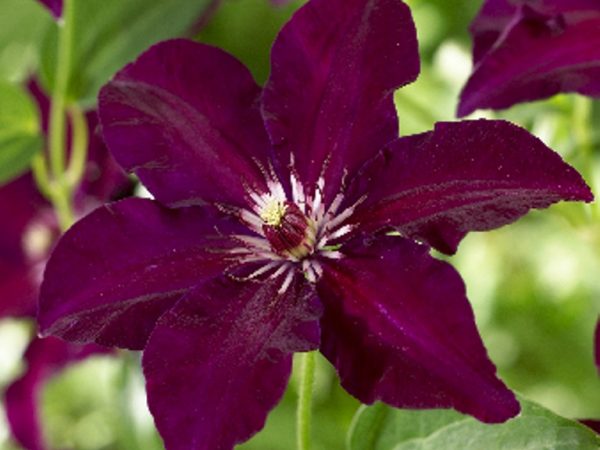
Clematis stasik trimming group
Powdery mildew. It appears as a white coating, similar to flour. The fungal infection spreads to leaves, stems, flowers, later the lesions become oily, darken, die off.
First, it is necessary to cut out diseased organs, then irrigate the crown with Skor, Topaz, Hom or Azocene.
Rust. Brown growths on leaves and shoots are a sign of infection. At an advanced stage, the foliage turns yellow, falls off, the stems droop and dry out. First, all infected parts are cut off, then the crown is irrigated with Ridomil gold, Quadris, Bordeaux liquid or copper sulfate.
Gray rot appears in wet and rainy conditions. Brown spots with a grayish bloom on the foliage are a sure sign of infection with gray rot.
Treatment: cut off all non-viable areas, spray the shrub with Azocene.
Wilt. This disease is incurable. It leads to the rapid wilting of stems, leaves and the death of shrubs. Therefore, a sick clematis is dug up, disposed of, and the place of its growth is disinfected with a fungicide.
Aphids withIt eats in colonies on the inside of the leaves, feeds on their juice, as a result, they wrinkle, turn yellow, dry out and fall off. With a minor invasion, home remedies are used - an infusion of garlic, tobacco, onions, hot pepper, or an ash-and-soap solution. The launched form is treated with Aktellik or Karbofos.
Nematoda preflects the root system, blocks access to oxygen, moisture and nutrients. As a result, the entire aerial part withers, turns yellow and dries. It is difficult to cure a shrub affected by this pest, so it is dug up and burned. The soil where it grew is spilled with a raspberry solution of potassium permanganate or copper sulfate.
Prophylaxis
To preserve the decorative qualities of vines, it is necessary to adhere to a number of simple preventive measures:
- buy healthy and robust plants;
- comply with the scheme and timing of landing;
- keep the site clean - remove weeds in time, weed aisles, cut off damaged parts;
- irrigate the crown in early spring and late autumn with a solution of copper sulfate or Bordeaux liquid;
- water, fertilize and cover in a timely manner for the winter.
How to apply in garden design
Perennial clematis Stasik is a valuable variety in landscape design:
- used as a tapeworm or in group plantings with other varieties of clematis;
- combined with decorative deciduous perennials - hosta, mosses, heather;
- used for landscaping vertical structures and surfaces - arches, terraces, pergolas, gazebos, walls of houses and outbuildings.
Gardeners reviews
Many give this variety only a positive characteristic:
- not afraid of frost, tolerates shearing well and can grow on all types of soil with the introduction of the necessary nutrients;
- it multiplies easily, therefore, over time, you can independently obtain several new bushes from a purchased plant to decorate your backyard area;
- a versatile liana that looks colorful against the background of any decorative vegetation.

